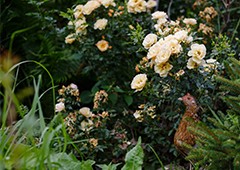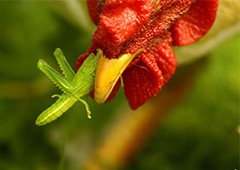Plants are truly remarkable things. They take most of its energy from the sun. They provide us with oxygen so we can survive. They even bear fruits on occasion for us to eat. Most incredibly perhaps is the wondrous ability that many plants have to form an entire new organism from nothing more than a branch or leaf. This is the equivalent of someone growing an entirely new human from a clipped fingernail! This act of garden magic may seem like something that belongs in the realms of science fiction, but it can be achieved by almost any gardener right at home in just 11 easy steps.
Hang on! What is propagation?
Generally speaking, propagation is the process of growing a new plant from cuttings that have the same genetic makeup of its parent plant. To use a hypothetical example, say you somehow grew a rare rainbow rose that the world has never seen before. Rather than just leaving that rose bush to eventually die out, you might decide to remove a few stems so that you can eventually replant it once it’s developed healthy roots, thus propagating that particular species of rose.
What plants are easier to propagate?
Some plants are easier to propagate than others. A very general rule is that the smaller plant the easier it will be to duplicate. Trees of course being the most difficult, while herbs and bushes are relatively easy. So, if you are a first time propagator, why not consider testing your skills on plants such as lavender, roses, rosemary, basil, coriander, parsley or mint, just to name a few.
Why do people bother propagating plants?
There are lots of reasons why people decide to propagate plants. Some avid green thumbs might decide to propagate certain plants if they feel it produces particular high quality fruit or is aesthetically superior in some sense. Sometimes gardeners simply grow attached to certain plants they’ve grown over the years and decide to take cuttings with them if they need to move house. Often the reasons can be as simple and as sweet as somebody wanting to share the beautiful plant they’ve grown with a friend or neighbour. No matter what the reason, propagation is a valuable skill that every gardener should try to get on top of at some stage.
So, how do I go about propagating a plant?

Propagating a plant basically takes place in three stages. The first being the cutting stage in which a stem is removed from the parent plant. The second stage is essentially cultivating those stem samples. The final stage involves transplanting the surviving healthy stems back into the garden so they can continue to grow fully. Each plant however will have its own quirks and particularities when it comes to cutting, cultivating and transplanting it, so it’s best to research a little into each particular plant prior to attempting to propagate it for the first time.
How do you get your cuttings?
The reality is that not all of your cuttings will survive the process of propagation, so it’s important that you make every effort to ensure that you choose the best stems from the parent plant. Here is what you need to know about selecting and harvesting cuttings…
-
For smaller plants like herbs, such as lavender, oregano and coriander, you are essentially looking for a mature yet relatively young stems, which are at least 8 to 10 centimetres in length.
-
Using a very sharp blade, such as a pruner, cut the stem on a 30 degree angle just below where the leaves are sprouting. This will increase the likelihood of the cuttings developing roots so that it can successfully grow into a plant of its very own.
-
Strip at least over half of the leaves off the stem, starting from the bottom and working your way up, as well as removing any flowers. This is so that the stem does not become sapped of any vital nutrients as it tries to develop a root structure that will ultimately keep the plant alive.
Once you’ve removed your cuttings from the parent plant it’s time to move onto the very fragile stage of cultivating to stems.
How do I cultivate the cuttings?

Cultivating the cuttings can be a frustrating and disheartening stage, especially if many of your stems die, however, so long as you have a plan, the likelihood of your new plants developing roots will only increase.
-
Once you have stripped the leaves from your cuttings, dip the base of the stems into a rooting hormone gel or powder. This will encourage your cuttings to quickly develop roots that are vital if the plants are to survive.
-
Fill pots with well-drained, chicken manure enriched, nutrient dense soil, with a PH of around 5.5 to 6.
-
Using a chopstick or a pencil, create a number of narrow holes in the soil that will snuggly accommodate your cuttings. Each pot will be able to accommodate several plants.
-
Plant the cuttings into the narrow holes you have made in the soil.
-
Place the pots in a well-lit spot- but ensure that it doesn’t get overwhelmed by direct sunlight.
-
Cover each with a plastic bag, using prongs to ensure that the cuttings do not come in contact with the plastic. This is designed to create a mini-greenhouse like climate, with high humidity, which will help your cuttings survive and thrive.
Like most other plants, these cuttings will need to be watered everyday, however it’s important that you also immediately remove any diseased leaves that might sprout, as they will only put these vulnerable plants in jeopardy.
How do I transplant the cuttings?
It will become clear relatively quickly which cuttings will survive and which will unfortunately find themselves in the compost bin.
-
Delicately tug at each cutting to see if roots are beginning to form. Cuttings with roots will feel more secure in the soil and put up some resistance.
-
Transplant the plants into the garden once they seem happy and healthy.
There are a number of variables involved when transplanting different types of plants, so it’s best that you research the quirks of each particular plant before relocating it to the garden. But, in essence, this is all you’ll need to do.
Many gardeners become addicted to the thrills, trials and tribulations and the deep sense of satisfaction that occurs when you successfully propagate a plant. Though some plants are easier than others, it isn’t necessarily one of the simplest things you can get up to in your garden, but the rewards are so worth it. Having an abundance of healthy soil and compost at the ready is one of the simplest ways to have success in your garden, no matter what you’re growing. A chicken tractor, like the Cluck House or Taj Mahal, with chickens of course, is one of the most effective ways to increase the quality of the soil all over your backyard.


















